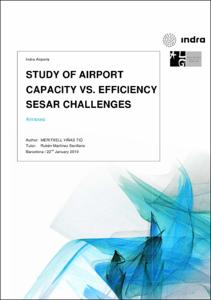Mostra el registre d'ítem simple
Study of airport capacity vs efficiency sesar challenges
| dc.contributor | Martínez Sevillano, Rubén |
| dc.contributor.author | Viñas Tio, Meritxell |
| dc.coverage.spatial | east=2.083294099999989; north=41.297445; name=C-32B, 08820 El Prat de Llobregat, Barcelona, Espanya |
| dc.date.accessioned | 2010-03-29T13:09:38Z |
| dc.date.available | 2010-03-29T13:09:38Z |
| dc.date.issued | 2010-01 |
| dc.identifier.uri | http://hdl.handle.net/2099.1/8898 |
| dc.description | The objectives of this study are to present a real case study for evaluating the impact of SESAR enhancements on the capacity and efficiency of the Barcelona – El Prat Airport by analyzing the impact of the future SESAR enablers on the capacity and efficiency indicators and by evaluating the effectiveness and the applicability of the SESAR concept on increasing its capacity and efficiency. The first half of the study is dedicated to analyze the following aspects of T1: - Capacity: current capacity of T1 was assessed, which in this case turns to be the capacity of the global Airport. Capacity is always given by the most restrictive subsystem, which in this case is the runway component. - Efficiency: a good indicator for evaluating the airport’s efficiency is an estimation of the delays. Given that runway component is the subsystem which limits the capacity of the airport, the delay introduced is a good KPI for efficiency. The results obtained from selected methodologies used in the capacity and efficiency assessments, (mainly FAA methods for airside and IATA for landside) show that, on 19th July 2009, Barcelona’s Airport capacity is 62 operations per hour and its efficiency 18.4 minutes of delay per hour on the runway component. Such conditions will be not enough to absorb the future traffic, even if operating at best performance, and it is here were SESAR will play a key role for the survival of Barcelona’s airport. The second half of the study is devoted to evaluate the SESAR scenario. The objective is to assess by how much SESAR will improve the capacity and efficiency of the airport and how this improvement will evolve over time. To this effect, the list of SESAR KPIs that will help in the determination of such parameters is obtained. The study concludes that both capacity and efficiency of Barcelona’s Airport are going to increase in the incoming years thanks to the new systems and procedures of the SESAR Program. - Thanks to new approach procedures (CDA), Barcelona’s landing capacity will be incremented, but because of current airspace limitations this improvement could not be reached by means of runway capacity since the airport is “closed” in terms of noise in the takeoff phase. - Thanks to SESAR CDM, delays will be reduced by a 3%, in means of improving Barcelona’s efficiency, which in values means 17.8 min delay per hour. Both factors will experience their biggest evolution rate from 2012 on until their entire completion on 2020 (63% for capacity and 67% for efficiency). This theoretical increase would mean, for example, that a capacity of 80 operations per hour could be reached by 2020. In terms of environment, SESAR will increase the capacity and efficiency of the Airport of Barcelona while minimizing the environmental impact of aviation on the surroundings of the airport by implementing its new environmental tools and procedures, such as CDA operating techniques which will reduce aircraft’s emissions and noise. The implementation of SESAR will represent an investment for the airport, and to this effect, a business case is presented, containing the analysis of the costs derived from implementing the SESAR requirements in the airport and the balance with the benefits obtained. CBA results show that Airport CDM is a solid investment given its technical applicability and economic viability, since benefits are 4 times bigger than implementation costs and the payback period is within only 2 years; all this at a nearly non-existent financial loss risk. To sum up, SESAR is an extremely positive option for the Airport of Barcelona, since it brings the necessary increases in capacity and efficiency in order to cope with future scenarios, and gives substantial economic benefits. |
| dc.language.iso | eng |
| dc.publisher | Universitat Politècnica de Catalunya |
| dc.rights | Attribution-NonCommercial-NoDerivs 3.0 Spain |
| dc.rights.uri | http://creativecommons.org/licenses/by-nc-nd/3.0/es/ |
| dc.subject | Àrees temàtiques de la UPC::Aeronàutica i espai::Aeroports |
| dc.subject.lcsh | Airport capacity |
| dc.subject.lcsh | Aeropuerto de Barcelona - Evaluation |
| dc.subject.lcsh | Airports |
| dc.title | Study of airport capacity vs efficiency sesar challenges |
| dc.type | Master thesis (pre-Bologna period) |
| dc.subject.lemac | Aeroport de Barcelona |
| dc.subject.lemac | Aeroports |
| dc.subject.lemac | Aeroports |
| dc.rights.access | Open Access |
| dc.audience.educationlevel | Estudis de primer/segon cicle |
| dc.audience.mediator | Escola Tècnica Superior d'Enginyeries Industrial i Aeronàutica de Terrassa |
| dc.audience.degree | ENGINYERIA AERONÀUTICA (Pla 2004) |







